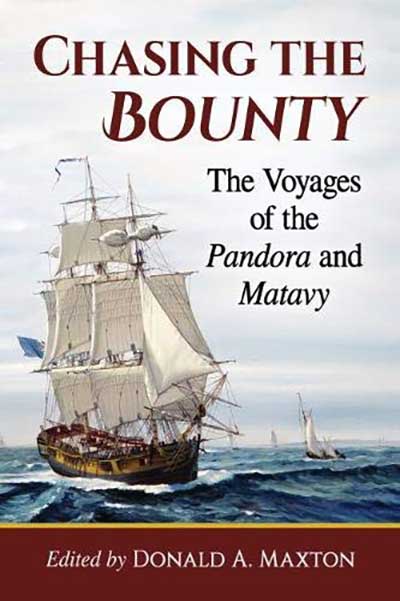Chasing the Bounty: The Voyages of the Pandora and Matavy
Edited by Donald R. Caxton
 Chasing the Bounty: The Voyages of the Pandora and Matavy, edited by Donald A. Maxton, continues the tradition. The book examines the expedition sent to recapture the mutineers. It tells of events aboard HMS Pandora a 24-gun frigate dispatched in search of the mutineers and the cutter Matavy, built by Bounty mutineers and seized when Pandora arrived at Tahiti.
Chasing the Bounty: The Voyages of the Pandora and Matavy, edited by Donald A. Maxton, continues the tradition. The book examines the expedition sent to recapture the mutineers. It tells of events aboard HMS Pandora a 24-gun frigate dispatched in search of the mutineers and the cutter Matavy, built by Bounty mutineers and seized when Pandora arrived at Tahiti.
The story is told through primary documentation. Maxton collected writings of those participating in the Pandora expedition, willing and unwilling. The quarterdeck view from Pandora is offered by Captain Edward Edwards (commanding Pandora), Pandora’s surgeon, George Hamilton, and Midshipman David Renouard. The book includes Edwards’s official dispatch to the Admiralty, Hamilton’s 1793 book about the expedition, and Renouard’s Voyage of the Pandora’s Tender (1791).
The last is Renouard’s report about the activities of Matavy after Matavy became separated from Pandora, and sailed independently to the Cape of Good Hope. Renouard commanded Matavy after it was seized and became Pandora’s tender.
Presenting the mutineers view of the voyage are letters written by Peter Heywood to his mother and sister during the voyage between Batavia and Britain, and James Morrison’s journal of the voyage. Heywood was one of the midshipmen aboard Bounty. Morrison was its boatswain, the driving force behind building the cutter seized by the Pandora.
Other documents round out the book: Pandora’s Admiralty’s sailing orders, a statement on Pandora’s loss by Edwards, Bounty court marital results, and an anonymous poem about Bounty and Pandora believed written by an officer aboard Pandora. These place the main part of the book in context.
Maxton took these documents, cleaned up the spelling and modified some punctuation and grammar to conform to modern standards. The result is a remarkable retelling of Pandora’s voyage from disparate points of view. Maxton captures each author’s voice. Edward’s writes in sparse language, while Hamilton is effusive. Heywood seems defensive, while Morrison is straightforward. (This is possibly due to when these were written. Heywood’s letters were written before the trial, Morrison’s account afterwards.)
Maxton divides his material by chronological sequence. His chapters cover different stages of the expedition: the outbound trip, the hunt for the mutineers at Tahiti, the search for the rest of the mutineers, and the wreck of Pandora, He breaks up each account. Readers move from Edwards to Hamilton to Heywood to Morrison in each section. (The order varies by section.) While it keeps events in order, it also disrupts the flow of each narrative.
Despite this, Chasing the Bounty is a valuable addition to Bounty lore. Much of its material has been unavailable for years in editions that contain errors. Maxton makes them available to modern readers stripped of inaccuracies. Maxton added introductory material, a glossary, and notes aiding readers’ understanding of the events. This book is a must for serious students of Bounty.
- Jefferson: McFarland & Company, 2020
- 6” x 9”, softcover, x + 190 pages
- Illustrations, appendices, glossary, notes, bibliography, index. $39.95
- ISBN: 9781476639741
Reviewed by Mark Lardas, League City, Texas
